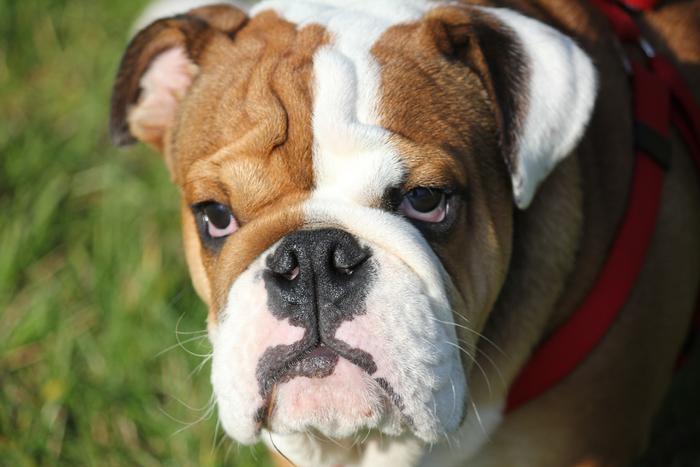Flat-faced dog breeds are popular all over the world. In the USA and in Hungary, the French Bulldog is currently the most common breed. However, their popularity comes at a high cost in terms of health: shortened skulls are associated with deteriorative brain morphology changes, breathing difficulties and sleep problems. According to recent findings by Hungarian researchers, flat-faced dogs sleep more because their breed-specific sleep apnea increases daytime sleepiness, their REM sleep phase is longer than non-REM sleep, and their sleep EEG patterns show signs of white matter loss.

Credit: Photo: Enikő Kubinyi
Flat-faced dog breeds are popular all over the world. In the USA and in Hungary, the French Bulldog is currently the most common breed. However, their popularity comes at a high cost in terms of health: shortened skulls are associated with deteriorative brain morphology changes, breathing difficulties and sleep problems. According to recent findings by Hungarian researchers, flat-faced dogs sleep more because their breed-specific sleep apnea increases daytime sleepiness, their REM sleep phase is longer than non-REM sleep, and their sleep EEG patterns show signs of white matter loss.
Despite being a health hazard, the large, round head may be an attractive dog feature for many people. Extremely flat-faced dogs, such as French and English bulldogs and pugs, live on average 3 to 4 years less than other dogs and often do not live to adulthood. Even in their short lives, they suffer from many ailments and undergo surgery to correct musculoskeletal, eye and respiratory problems. The abnormal shortening of the skull is also associated with a distorted, rounded brain, but it is not yet known how this affects neural functioning.
Hungarian researchers studied the sleep of 92 family dogs using EEG. “In the sleep lab, dogs spend about three hours with their owners. As nothing exciting happens, the dogs fall asleep quickly. Meanwhile, we conduct the electrical potential generated by the brain activity with electrodes glued to their scalps,” says Anna Kis, a pioneer in the study of sleeping dogs and a researcher at the HUN-REN Institute of Cognitive Neuroscience and Psychology.
“We wanted to investigate whether flat-faced dogs sleep differently from other dogs, as they are known to suffer from oxygen deprivation due to respiratory problems and therefore have poorer quality sleep. We found that the
flat-faced dogs slept more in the three hours given to them during the study. More daytime sleep is probably compensation for insufficient sleep at night.
But, when we studied the EEG patterns, we got more exciting results than that,” continues Zsófia Bognár, a PhD student who has been researching breeds of dogs with shorter noses, scientifically known as brachycephalic dogs, for many years.
When studying cognitive functions, special attention is devoted to the REM phase during sleep, also known as paradoxical sleep, because of high frequency brain activity similar to wakefulness accompanied by muscle atonia. For example, it is known from previous research that the amplitude of beta and delta brain waves (measured via EEG) during REM sleep is associated with learning success in dogs and intelligence in humans.
“In the present study, we found that brachycephalic dogs had decreased beta waves and increased delta compared to dogs with longer noses. The frequency of sleep spindles increased. This pattern has previously been associated with poorer learning in dogs and loss of white matter in humans,” says Ivaylo Iotchev, first author of the study published in the journal Brain Structure and Function.
“There may be several reasons for our results. The most interesting of these is that it seems as if the flat-faced dogs have retained the sleep pattern of puppyhood, similarly to newborns who spend more time in REM sleep.
It is widely assumed that brachycephalic dogs are selected for infant-like traits.
They have large heads and eyes, high foreheads and small noses because we humans find these traits irresistibly attractive. That’s how babies get us to care for them. It is possible that the selection of dogs to be infant-like in appearance has also infantilized their brain function,” says Enikő Kubinyi, professor and head of the MTA-ELTE Lendület “Momentum” Companion Animal Research Group and ELTE NAP Canine Brain Research Group. “But this is a bold assumption for now. What is very likely, however, is that breeding for brachycephalic heads leads to potentially harmful changes in brain function.”
Original paper: Iotchev, I.B., Bognár, Z., Tóth, K. et al. Sleep-physiological correlates of brachycephaly in dogs. Brain Struct Funct 228, 2125-2136 (2023). https://doi.org/10.1007/s00429-023-02706-y
Journal
Brain Structure and Function
DOI
10.1007/s00429-023-02706-y
Article Title
Sleep-physiological correlates of brachycephaly in dogs
Article Publication Date
24-Sep-2023




